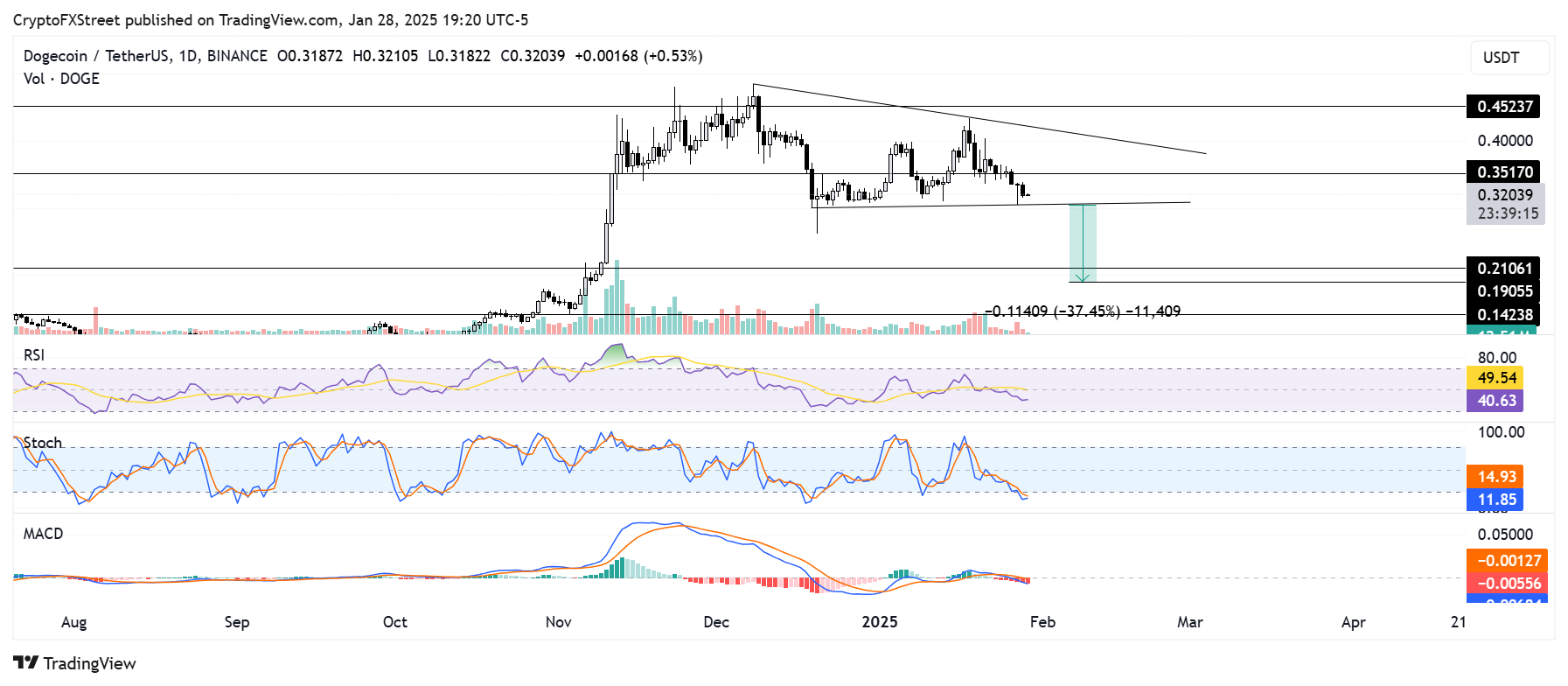- Joins the list of FNB and the same corner after having a Dogecoin ETF.
- The company had previously asked for a Dogecoin trust from Delaware last week, which hinted at a submission near the FNB.
- DOGE could decrease by 37% if it strikes a lower descending triangle limit.
DOGECOIN (DOGE) is down 4% after the deposit of the Bitwise Bitwise (ETF) Bitwise (ETF) with Securities & Exchange Commission (SEC). The upper coin risks a drop of 37% if it breaks the level of support for a triangular channel.
Dadecoin FNB is gaining momentum with deposits on the way
Bitwise on Tuesday submitted an S-1 recording declaration to the dry for an ETF of Dogecoin Spot. This marks the second ETF DOGE DIGATION with the regulator.
The Bitwise S-1 file was not surprised, given its Dogecoin confidence deposit in Delaware last week. The new file adds to the growing demand for FNB and the same corner after the inauguration of Donald Trump as President of the United States.
Before the Bitwise deposit, Rex Shares and Osprey filed a series of ETF requests for the pieces even like Doge, Bonk and Donald Trump last week.
“The reality is that there are many people who want to invest in Dogecoin. It is the sixth greatest cryptographic asset in the world by market capitalization and it exchanges more than $ 1 billion per day,” said CIO Bitwise Matt Hougan at the Financial Times.
This attracted mixed feelings, given the controversy that often accompanies the part of the pieces even.
However, due to the new presidential administration, the last ETF Doge should go through fewer obstacles to obtain approval.
In addition, the recent launch of the American Department of Government Effectiveness (DOGE), which presents the Dogecoin logo, has also strengthened the confidence of investors in the potential approval of ETF DOGE.
“There are many questionable investments packed in FNB, but the pieces even would bring this to an entirely new level,” said Nate Geraci, president of the financial advisor The Etf Store.
In others newsCBOE BZX has published a new set of deposits for ETF Solana to companies, including Bitwise, Vaneck, 21Shares and Canary Capital.
The exchange had previously submitted the 19B-4 documents in November, but received no response from regulators on its approval.
The foreign forecast suggests that the exchange is optimistic that the new dry administration approves ETF.
Doge risks that 37% decrease if it breaks the level of key support
Doge is negotiated in a triangle descending on the daily graphic. The best piece even extends its decline which started on January 22.
DOGE / USDT daily graphics
If DOGE supports a farm below the level of support for the lower limits of the triangle, it could decrease by around 37% to reach $ 0.1905. The level is obtained by measuring the height of the triangle and projecting towards the bottom of the potential escape point.
Going down, DOGE could find support near the level of $ 0.2106.
The relative resistance index (RSI) and the divergence of mobile average convergence (MacD) are lower than their neutral level, indicating the dominant downward pressure. The Stochastic oscillator (Stoch) is in the occurrence region, indicating that Doge may be due for a return.
A daily candlestick closing above $ 0.4523 will invalidate the thesis.
FNB Crypto FAQ
A negotiated stock market (ETF) is an investment vehicle or an index that follows the price of an underlying asset. ETF can not only follow a single asset, but a group of assets and sectors. For example, an ETF Bitcoin follows the price of Bitcoin. ETF is a tool used by investors to acquire an exposure to a certain asset.
Yes. The first ETF Bitcoin Futures in the United States was approved by the US Securities & Exchange Commission in October 2021. A total of seven ETF Bitcoin was approved, with more than 20 still waiting for the regulator. The dry indicates that the cryptocurrency industry is new and subject to manipulation, which is why it delays the FNB linked to crypto in recent years.
Yes. The SEC approved in January 2024 the registration and trading of several funds negotiated in exchange for Bitcoins points, opening the door to institutional capital and traditional investors to exchange the main cryptographic currency. The decision was welcomed by industry as a game changer.
The main advantage of the Crypto ETF is the possibility of obtaining an exposure to a cryptocurrency without possession, reducing the risk and the cost of active maintenance. Other pros are a lower learning curve and higher security for investors, as ETFs take care of the underlying assets guarantee. As for the main drawbacks, the main one is only in the investor, you cannot have direct property of the assets, or, as they say in Crypto, “not your keys, not your parts.” Other drawbacks are higher costs associated with the holding of crypto, as ETFs charge costs for active management. Finally, even if the investment in FNB reduces the risk of holding an asset, prices oscillations in the underlying cryptocurrency were also reflected in the investment vehicle.


